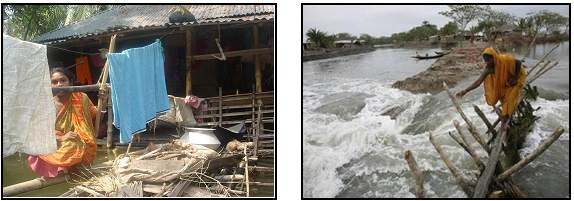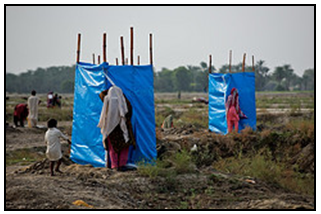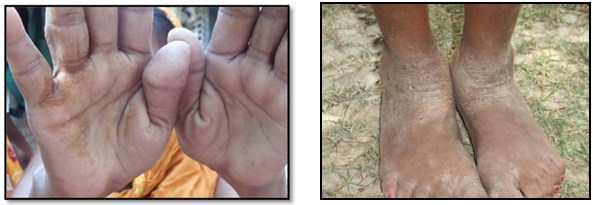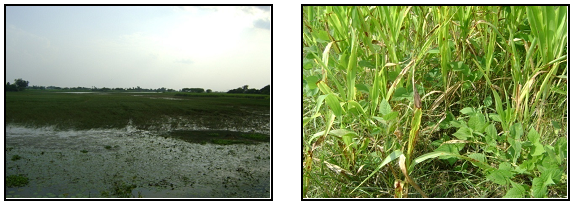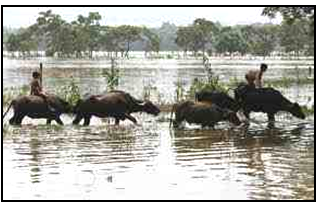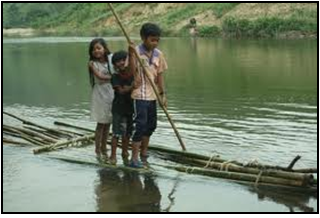Introduction
Roughly half of Bangladesh’s population is made up of women (48.9 percent in 2004, according to the World Bank gender profile), 80% of whom live in rural areas (BBS 2001). Flood affects everyone, it is not gender neutral. Poor women more are likely to become direct victims (mortalities and injuries) of climate change disasters, such as hurricanes and flooding (Neumayer and Plumper, 2007). Flood magnifies existing inequalities, reinforcing the disparity between women and men in their vulnerability to and capability to mitigate the impact and adapt with Flood. Women and children play multiple responsibilities at home but at the time of disaster they face tremendous problem.
Position of Women in Bangladesh
Specific social features in Bangladesh include seclusion and limited mobility of women, and the exclusive nurturing role assigned to them in the gender division of labor. Cultural values, religious norms, and social structures force women and children to be dependent on men. Most of the value systems in almost all Bangladesh societies believe in the need for protection of a male for women to carry on with life. At the same time, the social pressures arising out of the same value systems force the poor towards action such as female in feticide. According to the socio-economic indicators, the illiteracy of the overall population is considerably high and the gender disaggregated data points out that female illiteracy is always higher than male. The ownership of assets shows a similar pattern where women own fewer assets, since most societies follow a patriarchal system of ownership of property.
Some of the key factors contributing to women’s ‘double edged’ vulnerability owing to poverty and other social disadvantages in the Bangladesh context can be stated as follows:
- Very high illiteracy levels
- Low ownership of assets such as land, and other property (often inheritance laws are male oriented)
- Minimum work opportunities outside home
- Limited mobility out of home and out of their own locality
- Low social status and socially constructed dependency on male relatives
All these factors, the dynamics between them and the processes arising from the inter-relationships between them has resulted in women becoming an extremely vulnerable group in Bangladesh.
Women: Disaster
As mentioned the socio economic, cultural and religious values in Bangladesh have resulted in its women and female children in particular to be more vulnerable to adverse situations in comparison to men. These dynamics form into vicious cycles, where women and their children get trapped. Therefore, it is nearly impossible for women belonging to already poor and vulnerable groups to bounce back once hit by extreme events. The result in the worst scenario is often women becoming destitute with their children. In many societies, vulnerability to (natural) disasters differs for women and men. Women are often more vulnerable to disasters than men through their socially constructed roles and responsibilities, and because they are more poor. Disasters do not just happen. The social structure of most societies formally relegates women to inferiority and dependency, increasing their vulnerability through their disempowerment .Women is integral parts of functioning societies, with established roles and rule Adolescents, pregnant women, lactating mothers, the disabled, and the aged make up particularly vulnerable groups in emergencies. In the course of determining the impact of both natural and conflict induced disasters.
Women: Flood
The social structures of most societies formally relegate women to inferiority and dependency, increasing their vulnerability through their disempowerment. Women are often disproportionately affected as a result of the economic and social dislocation of the household. They have to deal not only with the economic devastation and disruption of livelihood systems but are left to cope with the social and emotional upheaval that comes from dealing with the death, disease and food shortages that invariably occur in the aftermath of floods. During flood women are more sufferer then men. The social and emotional affects of the damage that floods impose are often not even acknowledged as the main focus of rehabilitation is on the economic aspects of the damage.
Problem to Manage Basic Needs
1 Problem of Food
Poor people suffer from lack of food at the time of flood. Poor women have to wait all through the day and night for some food. Since most households are dependent on agriculture, flooding season is particularly threatening. In general, there is an overlap between flooding time and the crucial rice harvesting period. If a flood comes early in the monsoon season, it destroys the standing crop, which results in food shortages. Studies acknowledge that since women’s work is closely related to agricultural production, family food and income generation, the burden of food shortage falls on them.
Problem of Shelter
Problem of shelter is a common problem at this time. At the time of flood many families/women become homeless. It is sometimes impossible or not acceptable for a girl of marriageable girl to seek shelter in somebody’s house. They suffer for lack of suitable and secured shelter. Unemployed men often sit idle or move elsewhere leaving their households members behind. After a disaster hits there are often inadequate facilities available for women to cope with their household tasks or to get shelter.
 Problem of Clothing and Transportation
Problem of Clothing and Transportation
Women of the study areas face a great problem for their cloth at the time of flood. Traditionally women of our rural area wear shari. They cannot wear any other dresses due to shyness which are suitable to move at the time of flood. Poor people have very less clothed in the study areas. Poor women with only one shari are often oblige to remain in wet clothe for most of the day for lack of the private place to dry off. Women’s life also falls at risk, especially while travelling during floods the shari and the other parts have to wear with it become a death trap for women. They also cannot wash their cloth properly during flood period. There have no separate transport vehicles for women. They often use boat and banana tree made vella which is very risky for their life.
Source: Author& CDMP (2012)
Picture: Problem to move with “Shari” during flood
Problem of Sanitation
Women face countless difficulties using latrines than men during flood. It is impossible for women to disagreed their inhibitions and go to latrines, which are open to all. Women sometimes have to wait till dark/night to ensure privacy to respond to calls by nature, even changing clothes/sanitary pad which are really discomfort able to sufferer women. There is no separate sanitation system for women in temporary flood shelters and they feel insecure. In the flood shelter they have also problem to share toilet with others. Menstrual management was a severe problem as women did not have a place to change and wash dirty cloths and for using unhygienic sanitary latrine and in the open places they suffer from different urinary diseases.
Source: CDMP (2012)
Picture : Sanitation problem of women in flood
Impact on the Lives and Health of women
Impact on the Lives of Women
Flood is a part of human experience and reflects the close interaction of people with their physical environment. Men and women are affected by this. But a few studies following the flood disasters of 1991 revealed that, among women aged 20-44, the death rate was 71 per 1000, compared to 15 per 1000 for men (UNDP, 2005).In a flood, many women die while waiting for their relatives to return home and accompany them to a safe place. During flood, often more women die than men because they are not warned, cannot swim or cannot leave the house alone.
Impact on Health of Women
Diseases and Injury
Different threats exist during flooding. Deaths, diseases and injuries occur from waterborne diseases, snake bites, drowning, slipping, large trees and structures falling on women, lack of medical facilities, malnutrition, and lack of uncontaminated drinking water and lack of proper sanitation facilities. Women and adolescent girls offer as sanitation systems are destroyed, many women reported that they refrain from using the toilet during the day and consequently suffer from urinary tract infections. Women are more calorie-deficient than men, women have more problems recovering from the negative effects that flooding has on their health.
Reproductive and sexual health problems
Pregnant women, lactating mothers and differently disabled women, aged women suffered the most, as they found it difficult to move before and after the flood. For the insufficient food they suffer by malnutrition. Due to malnutrition i.e. for vitamin A, iodine and iron deficiencies female children, pregnant women and lactating mothers get eye diseases, Xerophthalmia/night blindness, anemia, goiter etc, which increase the number of visually impaired and disabled people in the country. Women are more calorie-deficient than men, women have more problems recovering from the negative effects that flooding has on their health.
In addition, women are vulnerable to reproductive and sexual health problems. The study shows the adverse reproductive outcomes such as early pregnancy loss, premature delivery and delivery-related complications. In most cases, they have to walk long distances and standing long queues for collecting relief with their wet clothes clinging to their bodies. Flood relief efforts pay insufficient attention to women’s reproductive and sexual health, and as a result women’s health suffers disproportionately.
Source: Author (2012)
Picture : Skin problems of women in flood
Psychological problem
At the time of flood maximum women become upset and worried for increase of responsibility. The bitter truth is that in such distressing situation some of the poor girls and women are enticed by pimps. When they suffer for lack of money, food, water and become victim of different harassments then they lose their mental strength.
Case Study 1:
Maloti Dash, a housewife aged of 36, from Bil Nuruddinpur village of Rajbari sadar upazila said that “I have seven children (4 boys and 3 girls). The floods collapsed our three rooms and washed away our crops, maize and late millet. As a result, we harvested nothing. Hunger stared us straight in the face. I have been traveling long distances every morning to collect firewood for sale to feed my family. Getting firewood is now very difficult and most times. I have to climb trees to check for dried branches to cut. Sometimes I do this with my 9 month old baby on my back Male members do not go to bring non-saline water. I walked around 2 kilometers to fetch water … ”
-(Source: Survey- 2012)
Case Study 2:
Rashida Begum, a housewife aged of 25, from Khorda Gajail village of Ullahpara upazila said that “I was five months pregnant during last severe flood and suffering from malnutrition. I ate cooked rice with salt or rice soaked in cold water at that time. She also said “Most of the time I did not eat anything else then. After a while, she was unable to stand due to pain in her lower abdomen. The child in her womb stopped moving. My husband was not at home during that period. I did not have enough money to go to a doctor. Once I went to visit the doctor. He was very busy with other patients and asked me to come the next day. I spent 20 taka to visit him. It is impossible for me to spend money during flood time. I doubted whether my unborn child could see the light of the world…”
– (Source: Survey- 2012)
The UNDP Human Development Report of South Asia, 2002, ranked Bangladesh third of the countries in which violence against women is highest and most regular.
Impact on women’s physical security
During and after flood women in Bangladesh still experience various types of violence, and physical, sexual and emotional violence increases.
Harassment and loss of privacy in flood shelters
Many women refuse from going to shelters during a disaster or when a warning signal is issued that they fear would have to share a room with strange men, due to loss of privacy and physical and mental abuse and torture. Pregnant women and nursing mothers tend to be reluctant to share space with or nurse in front of strangers. Some women with disabilities also mention facing some form of violence in shelters, including mental abuse and physical torture.
Source: Author & CDMP (2012)
Picture 6.5: Insecurity and loss of privacy of women in flood
Harassment in relief queues
Women’s physical insecurity and loss of dignity is very common while they collecting relief during or after a disaster. Women often face additional Sexual harassment .They have to walk long distances through water, their wet clothes clinging to their bodies, to collect relief. During collection they have to stand in long queues with male strangers. So, many of them do not want to go to collect relief, though they have serious need.
Domestic violence
In the aftermath of flood an increase in domestic and sexual violence often occurs. Domestic violence is one of the problems in during and after flood, as psychological stress increases during flood that more men are left without employment, male relatives of many women have been reported to vent this increasing frustration via abusive language or exertion of physical force. Husbands often beat their wives and children when food-supply run out in the flood stricken households. During or after flood, such as long periods of flood more girls drop out of school to reduce household expenses by saving on school fees, or to assist in the household with tasks such as fetching water, or as a result of pregnancy and early marriage. Girl-children are married off early in times of drought, usually to older men with numerous sexual partners. They were even forced to sell sex for gifts or money, which resulted in the accelerated spread of sex related diseases in the country. These reasons are abused range from women not being able to manage resources properly, to not serving food on time, to not being able to procure relief materials.
Impact on women’s economic livelihoods
When poor women lose their livelihoods, they slip deeper into poverty and the inequality and marginalization they suffer from because of their gender division increases. Therefore, flood presents a very specific threat to their security. Floods damage livestock -cows, goats, buffaloes, and poultry -chickens, ducks, fisheries, trees, crops -rice, wheat, nuts, chilies, lentils, seeds and animal fodder. Sand deposition as a result of flood and river erosion affects production of crops such as nuts. During and after flood, the lack of fodder for livestock and poultry results in reduced milk and meat production. An increase in the number of female-headed households (because of male out-migration) also amplifies women’s responsibilities and vulnerabilities during natural disasters. The impacts of floods on the livelihoods of women include:
Crop production loss:
Most of the family of the study areas maintains their livelihood by growing different types of crops. Women also work in the crop field with the men. Women, who control homestead-based livelihoods, lose income when crops are blown or washed away. For this they suffer for lack of food after flood and their earning sources decreases.
Source: Author (2012)
Picture : Crop damage and washed away at the time of flood
Livestock Death
Cows and goats are the most valuable assets of poor people in flood-prone areas. During flooding, collection of fodder for livestock is a significant challenge, particularly for goats that need green grass (which often becomes flooded). Women also face a great problem to keep their livestock in a safe place. Many livestock die at this time for lack of food and drowning in the flood water.
Source: Author (2012)
Picture : Problem to maintain livestock in flood
Housing and homestead
The destruction of houses by floods is a common impact in disaster prone areas. Homestead vegetation which is maintained by the female family member is damage by flood and decrease the earning source of women.
Loss in productivity
Flood water and sand deposition decreases soil productivity. So, the food insecurity situation has been worsened by the floods.
Supply shortage and price of inputs
Shortages during flooding leads to increased prices for inputs such as seeds, fertilizers, oil for running irrigation pumps, fodder for animals, transport costs and veterinary fees.
Loss of income, savings and employment
Loss in production, lack of storage and destruction of access roads result in assets (e.g. cattle) or products (e.g. milk) being sold at low prices. The selling price decreases while the shortage in supply induced by floods results in increased prices for essential goods. Moreover, flood reduces employment opportunities, especially for women working in agricultural fields. Less income of women means less food at home for children. As a result, there is a net loss in income which, in turn, leads to a loss in savings, thus making it even harder for households to cope with disasters.
Limited access to market
With damages to infrastructure and communications systems, women cannot access the market to buy or sell food such as milk, eggs, vegetables or other products. Women are forced to trade within the village or accept lower prices offered by male buyers from other area.
Also many another socio-economic impact of flood on women is seen in the study area. Among them those mentioned are more common and miserable.
Case study 3:
Aleya Khatun, 42, Khorda Gajail, Ullahpara said that “The price of everything goes up after a flood. The price of seeds, fertilizer and oil all increase. The price of food for man and animals also increases. We have to eat less and feed our livestock and poultry less. Some of our livestock died”
-(Source: Survey- 2012)
Case Study 4:
Momena, 45, Bil Nuruddinpur, Rajbari Sadar said that “The roads get submerged and slippery. Even if I have paddy at home I can’t go to the market to sell it. We are also unable to sell the milk and the vegetables we produce. So we have to accept low prices from buyers within the village or external buyers who approach us. Our earning amount decreased after the flood”
-(Source: Survey- 2012)
Face gender division of labor
Women’s responsibilities in the family make them more vulnerable flood, which is exacerbated by the impacts of flood. Women who are virtually household based workers have to take responsibilities to for protecting their houses, children, live-stocks and belongings. Traditional gender specific works such as caring for children and animal naturally become too difficult for them during flood. It becomes more painful for the women to observe their routine household chores. Often there is no alternative because there are no men around them to help and even if there are, they do not assist with women’s work because for the powerful ideas of gendered division of labor. For lack of resources poor women face more problems than women belonging to middle class and rich households. They are often less mobile, more likely to be confined to the house and have less decision-making power.
Source: Author & CDMP (2012)
Picture: Multiple works of women in Flood
Discrimination between women and men
Women also face indirect problems when natural disasters strike. They are often less mobile, more likely to be confined to the house and have less decision-making power. All of which contributes to their lack of participation, and lack of access to information regarding potential hazards and possible adaptation strategies. Besides diminishing their visibility, these realities deprive women of opportunities to look for alternative sources of income, adversely affecting their bargaining power in the household and community. Discrimination between men and women increase at the time of flood. Post disaster rehabilitation is often overlooked due to gender discrimination. Weather forecasting information networks or early warning systems often do not take into account women of the coastal areas. Due to their limited access to information, women are less able to minimize risks. There is discrimination of wages between male and female are seen.
Problem of Marriage
The impact on women, as recorded demonstrates the high social values attached to marriage, from a security point. From the affected women’s view point, their land and houses gradually being washed away by the river has denied or delayed the chances of their marriage. The financial constraints have compelled the families to sell the dowries of the daughters and the jewelry of housewives, causing delay in marriages of the girls and rise of insecurity among the housewives. It is further mentioned that delay in marriage in an overly suppressed atmosphere of a tabooed society caused many psychological problems for the girls instigating feelings of worthlessness and self pity.
Children: Flood
Children are very vulnerable during any disaster situation. Given that a significant proportion of the current flood disaster’s victims are children, it is vital to pay foremost attention to safeguarding them. Displacement, the threat of exploitation, severe malnourishment and health risks are problems affecting children in the immediate future. Children become more distressed at the time of flood. People and children are surrounded with hunger and illness. They are also more likely to die.
Impacts on lives and health of children
Children are the worst sufferers during flood. They face countless difficulties, live inhumanly and survive at the cost of one’s life. Floods carry risks to psychological as well as physical health of children.
Physical problem
The floods have already had a great impact on children’s health making them particularly vulnerable to different diseases. Since children are not in school, they are spending time playing in water and mud. This has resulted in skin diseases, fever and other water-borne illnesses. Diseases spread broadly and sometimes as an epidemic, especially diarrhea, dehydration, pneumonia, jaundice etc. Due to malnutrition, i.e. for vitamin A, iodine and iron deficiencies children get eye diseases, exophthalmia/night blindness, anemia, goiter etc, which increase the number of visually impairs and disabled people in the country. Babies born to malnourished women are particularly at risk. As they have low birth weight, they are more likely to get ill and their overall development could be severely impaired in the years to come.
Floods carry a high cost, which lead to increase in both wasting and stunting among pre-school children, cause them to fail to grow at a critical point in their mental and physical development. Increase of malnutrition during flood or disaster has enormous costs misery, pain and ultimately death for the children. For flood and week communication system taking necessary vaccine of the children hampered.
Source: Author (2012)
Picture : Physical problem of children during flood
Psychological problem
Where thousands of people are undergoing mental torture due to floods and its aftermath, children also have a deep impact on their minds. When floods occur, children may witness anxiety and fear in usually confident parents and caregivers. They may see adults’ best efforts fail to protect their homes. At this time increased feelings of insecurity, unfairness, anxiety, fear, anger, sadness, despair, worry about the future, and dread of a flood reoccurring. Some have already started to develop minor mental problems, which might augment in the near future.
Children may also experience the horror of seeing severely injured people or dead bodies. The violence that occurs during receipt of aid from relief volunteers has been creating a deep impact on children. Trauma and chronic distress affects children deeply and many of the children affected by these floods will be facing enormous stress at losing people or pets they loved, seeing their homes, schools and favorite parks and playgrounds destroyed – even just seeing this happen to others via the TV is enough to stress a child.
Injuries of children
Different types of injuries are one of the common incidents for children at the time of flood. Major Child injuries are defined according to categories such as cuts, falls, burns, road traffic accidents, animal bites specially snake bite and near drowning, injury from house collapse. Injuries were defined as having physical attack at night by thieves.
Education condition of children
At the time of flood the education of flood affected children are greatly hampered. The schools remain closed due to flood water. Some two storied schools also use as flood shelter in some area. Children cannot go to school as their communication system damaged. The schools or child care arrangements may be temporarily or permanently closed, causing the children and their parents to scramble for new arrangements and often for children to be placed in strange and unfamiliar environments. At this time increase school-based problems, with decreased motivation and a decline in school performance. Children have lost as a result of the flood (toys, books, sports equipment, and age-appropriate educational materials as well as clothing and other necessities).
Peoples also beliefs that learning to swim is a must and majority think that children should be encouraged to learn to do labor work and develop other skills except for the few who wants to encourage education. Learning to swim to increase coping capacity can be encouraged but the wrong notion of the people about not promoting education is definitely due to the poor economic condition and unavailability of proper education system in the village and the neighboring village
Picture 6.12: Problem to going school during flood
Domestic Violence
Children are exposed to or experience domestic violence in many ways. Domestic violence poses a serious threat to children’s emotional, psychological, and physical well- being, particularly if the violence is chronic. Domestic violence increases at the time of flood. There have risk of flood-affected children being kidnapped by militants, the dangers of lost and displaced children falling prey to trafficking, sexual abuse and kidnapping are real.
Emotional violence
Emotional violence disrupts the ego of children. Emotional violence was said to occur when a child’s parent said or did something to humiliate the child in front of others, or in front of someone close to the child, or threatened the child with harm. This definition was also as same way applied to a situation where the husband abusing the respondent.
Physical violence
Different types of physical violence increase at this time The respondent or her husband physically abused their child by pushing, shaking, beating throwing something at him or her, slapping or twisting, punching with a closed fist or with something that could hurt or kicking or dragging the child, by trying to burn, strangle or attack the child with a knife, gun or any other type of local weapons which he have to attack the children.
Sustenance abuse
Sustenance abuse was said to have taken place when the respondent or her husband or both stopped the daily food intake to the child because of any kind of worse situation; or if the respondent’s husband stopped food intake for the respondent (his wife).
Sexual violence
Sexual violence was defined as respondent’s husband physically forcing her to have sexual intercourse with him against her wishes, or forcing the respondent to perform other sexual acts against her wishes. Women and girls who go to transplant and harvest rice, schools, shops in other villages, there are increased risks of physical and particularly sexual abuse, or sexual harassment or rape. They also face this sometimes in the flood shelter. Rape is one of the important incidents which occur with the girl child at the time of flood.
Child labor
During or after disasters, such as long periods of flood, more girls drop out of school to reduce household expenses by saving on school fees, or to assist in the household with tasks such as fetching water, or as a result of pregnancy and early marriage. After the flood many women and girls are engaged in intense family recovery efforts. Children are regularly dropped out of school to help their mothers to gather wood and water. There are numerous accounts of single women affected by flood whose children are never sent to school but for begging for family survival.
In families hit particularly severely by the flooding, the most common response is migration for work by husbands, sons and/or daughters. Women and young adolescent daughters remaining at home shoulder most of the responsibilities vacated by those who have migrated. This is often coupled with an increased need to earn income through rice transplanting and harvesting, over and above that which they would normally do. For the collection of wood as fuel children’s have to climb the long trees which is very risky for them.
Source: Author (2012)
Picture : Child labor increase during flood
Occupation condition of children
At the time of flood there have no scope for the poor children to gain any type of working ability for their livelihood. To support the family many poor children engaged in different occupation like rickshaw/Van pulling, mechanics, tailoring, selling different goods in the bazaar etc. All these works are hampered during flood. Men and older boys engaged in fishing or fodder collection by boat were considered to be at high risk. Although most men and adult boys are not strong swimmers the main risk is perceived to be from sudden storms, big waves or boats sinking or capsizing rather than an inability to swim. Women or girls engaged in small-scale fishing around the house or village, or in collecting fodder or firewood from areas of high ground within the village.
Case Study 3:
Nasima, a 15 aged young girl, got married at a very early age from Khorda Gajail, Ullah para, used to provide domestic help to neighboring households. “I amunable to work now due to having headaches all the time. When my husband gets angry, he hits me in the head”. Nasima says that, although her husband has been violent since their marriage began, “it has increased after the flood of 2010. My fault is that I was not able to get relief… Whenever he is angry, he hits me in the head, waist and legs and asks, ‘How do other women receive 20/30 kg of rice?’ ‘Why don’t you beg for rice from the Commissioner?’ He does not give us food regularly but is regular in beating.” Nasima feels that as long as he can feed the family, she is willing to digest all his beating.
-(Source: Survey- 2012)
Case study 4:
Ten-year-old Khairun lives in Bil Nuruddinpur villaga. “After the floods began, I lived through the worst days of my life,” she said. “To escape from the floods we moved to Rajbari town to my brother-in-law’s house. But that place was very small and since my family is large we shifted to a relief camp. People behaved very badly there and used to harass poor people and women. Women here have to wait till dark/night to ensure privacy to respond their sanitary works. I also faced problem to clean clothes/Sanitary pad which is a common problem in flood shelter and also faces mentally harassment in the relief queues. I was greatly troubled in the camp and never left our tent. I was also very scared and used to cry a lot.
–(Source: Survey- 2012)
Recreation of children
Recreation problem of children is a common problem of the children during flood period. At the time of flood children get a little scope for playing and other types of entertainment. Parents never allow the child’s to go outside the home whose age is under 5. Their daily routines may be seriously disrupted, and regular contacts with their friends may be put on hold or impossible to maintain. The playgrounds submerged by flood water for a long time. For this reason they do not get scope of playing. The children spend some time by swimming and boating. All young children are considered at high risk, either through their enjoyment of playing in the flood water itself or because of the risk of falling from the house into the floodwater. It is very hard for them to spend the rest of the time. Maximum children enjoy radio programs. For spending lazy time some of them become child criminal.

